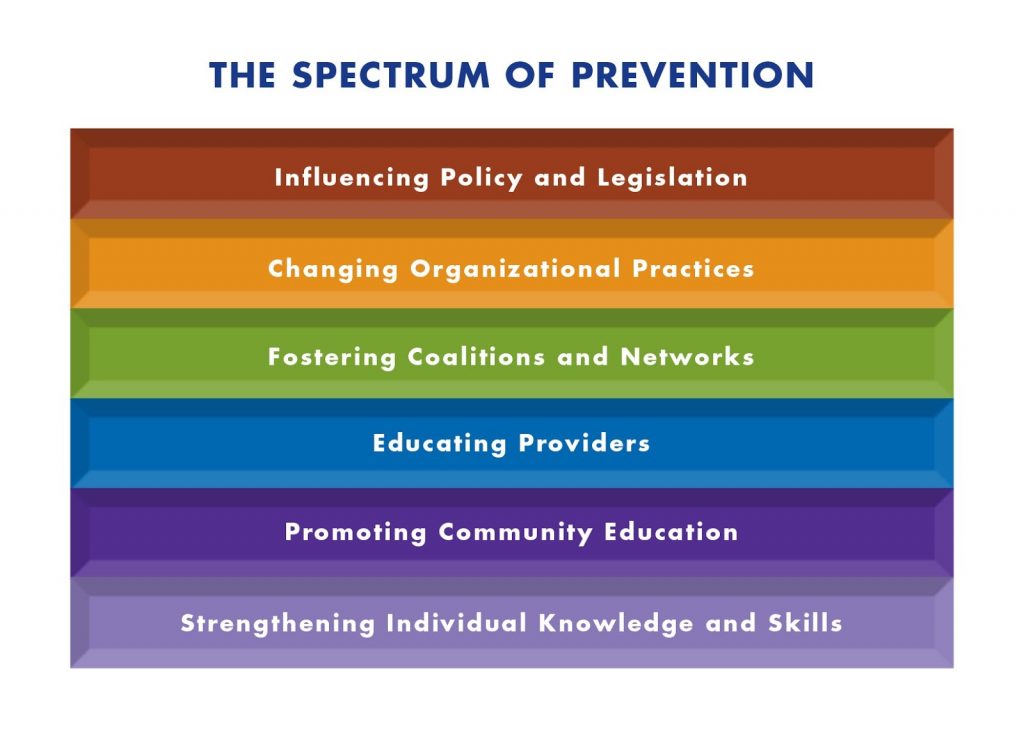The purpose of this facilitation guide is to help Extension Educators inform and engage community leaders about the changing demographics of our communities and why these demographic changes are happening, as well as invigorate discussion and planning about how communities can adapt to changing needs. Your role as an educator is to make this information meaningful to community leaders; plant the seeds of how they might act upon the information you provide; and provide resources to help them follow-through to enact community-level and policy-level change. The goal is not to create or add more Extension-led programming, but to help communities see these changes as an opportunity for systems and policy level change to support all of us as we age. Figure 1 shows the Prevention Institute’s Spectrum of Prevention – with this programming, we are targeting the top levels of the spectrum.

Figure 1. (Courtesy of Prevention Institute)
This facilitation guide is set up to steer you through the process of engaging with your community on this important issue. With having more older adults in our society, we have an incredible opportunity to curate innovative solutions to support all of us as we age as well as a collective responsibility to develop aging-friendly, livable communities. As part of this work, it is critically important to talk about the values of why this important, use explanatory metaphors to boost the explanatory power of your communication, and to end with concrete solutions to show we all can make a difference (Frameworks Institute, 2017).
This guide is designed to be flexible (“choose your own adventure”), as different groups have different needs. Rather than offering step-by-step instructions, this guide will walk you through what you need to think about and how to make a decision to present this information to your unique community. The “Are you Ready?” section of the guide provides some considerations when deciding to move forward with this work. Under “Identifying Goals” Extension Educators will be guided to identify which group(s) they will be working with and consider the goals of the group. The “Background” section of the guide summarizes the causes of this demographic change and the importance of nurturing an aging-friendly/livability focus in communities. The “Survey” section provides some background on the creation of the survey, and links to both a hard-copy and online version of the survey. The “Characteristics” section provides detailed information about each of the thirteen aging-friendly characteristics referenced in the survey, including potential data sources and activities to help bring home the importance of these issues, and examples of success stories, resources, and possible next steps to translate enthusiasm into prioritization, strategic planning, and community-level change. Finally, the “Evaluation/Impacts” section provides suggestions on ways to review your work, the “Resources” section provides links to other similar assessments and useful resources, and the “Templates” section houses sample documents that may be useful as you advertise and promote this work.
Throughout the guide we will highlight the various ways that the Aging-Friendly Community Characteristics Survey can be used to inform and facilitate systems-level change with several “typical” uses, guidance on how to utilize the survey and development of next steps.
As a final note, this is intended to be a living document. We hope to streamline the process of engaging communities in conversations about population aging, and will therefore continue to tweak this toolkit to make it as usable as possible.
Feedback, comments, or success stories? Please share them with us by emailing Sara Richie or Kristin Litzelman
Up Next: Are You Ready? |



